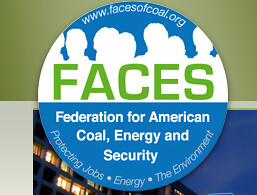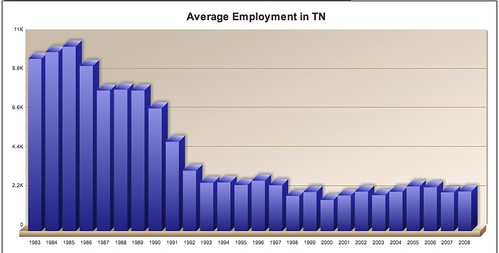(via the Center for Biological Diversity and EEN. -jdub)
 WASHINGTON- A broad coalition of more than 300 faith, human-rights, social justice, and environmental groups sent a letter to U.S. senators today calling for energy and climate legislation that is much stronger than the Waxman-Markey bill that passed the House of Representatives June 26. That bill contained massive giveaways to polluting special interests and would fail to ensure a rapid transition to clean energy.
WASHINGTON- A broad coalition of more than 300 faith, human-rights, social justice, and environmental groups sent a letter to U.S. senators today calling for energy and climate legislation that is much stronger than the Waxman-Markey bill that passed the House of Representatives June 26. That bill contained massive giveaways to polluting special interests and would fail to ensure a rapid transition to clean energy.
The groups plan to hand deliver the letter to senators’ state offices next week as part of a larger, grassroots mobilization demonstrating far-reaching support for bold leadership in the fight to solve the climate crisis.
In the letter, the groups express “profound concern” about the House bill and ask senators to usher in “the transformational change and greenhouse emissions reductions required to avert catastrophic climate impacts.” The letter calls for legislation that:
* Reduces atmospheric CO2 concentrations to a safe level of below 350 parts per million;
* Maintains existing Clean Air Act protections against global warming pollution;
* Minimizes the use of offsets and other loopholes;
* Protects vulnerable populations and communities;
* Promotes abundant clean energy;
* Eliminates polluter giveaways; and
* Adheres to preexisting U.S. commitments to the rest of the world.
Comments from a few groups that signed the letter follow:
“We haven’t yet seen the bold leadership from Congress that’s required to solve the climate crisis,” said Church World Service Director of Education and Advocacy Rajyashri Waghray. “We’re sending this letter to demonstrate broad grassroots support for such leadership.”
“We have to have a stronger climate bill than the watered-down version that passed the House,” said San Bernardino Valley Audubon Society Conservation Chair Drew Feldmann.
“We’re organizing on the ground, in communities around/throughout the country, to mobilize the everyday people who will feel climate impacts, and to defeat the entrenched, polluting special interests in Washington and pass a truly strong bill in the Senate,” said Appalachian Voices Legislative Associate J.W. Randolph.
“The everyday people of America have been left out of the climate debate. We are building a grassroots movement that reflects the diversity of America, to mobilize everyday people who are experiencing the affects of climate change. We aim to defeat entrenched fossil fuel polluting special interests in Washington and pass a truly strong climate bill,” said Tom Goldtooth of the Indigenous Environmental Network.
“There’s an impressive breadth of groups on this letter, and it demonstrates that the status quo isn’t acceptable. Congress must pass a bill that actually gives us a fighting chance of avoiding runaway global warming. There’s no other option,” said Tyson Slocum, who directs Public Citizen’s energy program.
The letter reads as follows…
—
The Honorable Barbara Boxer
Chairwoman, U.S. Senate Environment and Public Works Committee
Hart Building 112
Washington, D.C. 20510
Cc: Members of the Senate and President Barack Obama
Dear Senator Boxer,
Thank you for your continued leadership on the climate crisis. The environmental, economic, and public health threats of global warming — both in the United States and around the world — require a strong climate bill. We are profoundly concerned that as currently written, H. R. 2454 (the American Clean Energy and Security Act or “ACES”) falls far short. We are writing on behalf of the millions of members our organizations represent to urge you to draft a companion bill that provides the transformational change and greenhouse emissions reductions required to avert catastrophic climate impacts.
The Senate bill must set an economy-wide cap on greenhouse emissions that is consistent with the best available science and that can be ratcheted down as necessary. Findings from the U.S. Global Change Research Center, Intergovernmental Panel on Climate Change, and many other institutions and scientists indicate that the atmospheric greenhouse gas stabilization target of 450 parts per million CO2eq is far too high to avoid the risk of catastrophic climate change. Leading scientists currently warn that CO2 must be reduced to no more than 350 parts per million. Yet the cap set by H. R. 2454 is insufficient even to achieve 450 parts per million CO2eq. The Senate bill must contain reduction targets consistent with the best available science, representing the U.S. fair global share of reductions within the world’s remaining carbon budget, and it must include immediate action on short-lived global warming pollutants, including black carbon and methane, to slow warming in the near term.
The Clean Air Act already provides many of the necessary tools to reduce greenhouse pollutants. Therefore, the Clean Air Act rollbacks in H. R. 2454 — which would actually reduce existing pollution control requirements, facilitate the construction of additional coal-fired power plants, and grandfather in unnecessary pollution from existing plants — must be removed. The critical safety net of the Clean Air Act must be retained, not discarded in favor of a new, untested system, placing all of our eggs in one precarious basket. Existing Clean Air Act authority should be strengthened by adding deadlines for the oldest and dirtiest coal-fired power plants to meet pollution reduction requirements or shut down.
The Senate bill should eliminate the many loopholes in H. R. 2454 and ensure the integrity of the pollution-reduction system. A top priority must be to eliminate or greatly limit and restrict offsets, which allow actual pollution from capped sources to increase, creating localized toxic hotspots in people of color and vulnerable communities; delay a shift to low carbon technologies in the United States; and increase the risks in carbon markets. In addition, the House provision prohibiting a full life-cycle analysis of biofuels must be reversed.
The Senate bill should protect low- and middle- income families. Regardless of the chosen mechanism, the setting of carbon prices must be transparent, stable, and predictable, while minimizing the ability of private entities to manipulate the carbon price. We do not believe the market mechanisms contained in the current cap-and-trade proposal achieve this. The Senate bill should ensure there are adequate protections from climate change for low-income families, vulnerable communities domestically and globally, and Native American and indigenous peoples, including protections and dividends for low-income consumers and adequate international
finance for adaptation. The Senate bill should provide for abundant clean energy. The Senate bill should provide mandates and
incentives for abundant clean energy sources such as low-impact solar, wind, and non-dam hydro, which do not add toxic burdens to communities and workers and do not require incineration technologies.
The Senate bill should eliminate polluter giveaways, including massive subsidies to coal and oil. Scarce government funding should not go to dangerous fossil fuel or nuclear industries or allow damaging practices such as mountaintop-removal mining. Instead, public money should go to investments in energy efficiency, renewable energy, and the creation of green jobs.
The Senate bill should live up to the United States’ international obligations. For a fair global deal with meaningful global emissions reductions, the United States must both deeply reduce emissions domestically and provide adequate international climate finance for clean technology, adaptation, and support to stop deforestation. Fulfilling these commitments will be essential to securing an effective international agreement.
We recognize the massive political effort that is necessary to pass climate legislation, but a bill with inadequate targets, loophole-ridden mechanisms, rollbacks of our flagship environmental laws, and inadequate financing to help developing countries address climate change will move us in the wrong direction. We urge you to pass a strong climate bill consistent with the principles outlined above.
Thank you.
Sincerely,
…
350.org
Acterra
ActionAid USA
Alameda Creek Alliance
Amazon Watch
American Center for Life Cycle Assessment Institute for Environmental Research & Education
Animal Welfare Institute
Animas Valley Institute
Anza Water Conservation Association
Appalachian Voices
Arizona Wilderness Coalition
Atlanta Mentorship Program for Sustainability
Audubon South Carolina
Battle Creek Alliance
Bedford Global Warming Coalition
Berkeley Partners for Parks
BioTour
Blanket the Globe
Borneo Project
California Coastkeeper Alliance
California Interfaith Power and Light
California Native Plant Society
Californians for Western Wilderness
Calumet Project
Canary Coalition
Caney Fork Headwaters Association
Carolina Biodiesel, LLC
Carolinas Clean Air Coalition
Carolinas Clean Air Coalition
Caribbean Conservation Corporation
Cascadia Wildlands
Center for a Sustainable Coast
Center for Biological Diversity
Center for Native Ecosystems
Center of Concern
Center on Race Poverty and the Environment
Central California Environmental Justice Network
Central New Mexico Audubon Society
Chalice Farm and Sustainable Living Center
Champaign County Audubon Society
Chesapeake Climate Action Network
Church World Service
Citizens Against Ruining the Environment
Citizens for Quality Environment
CitizensforSanity.Com, Inc.
Citizens for Sludge-Free Land
Citizens League for Environmental Action Now (CLEAN)
Citizens United for Resources and Environment (CURE)
Clarksville Warioto Chapter of Audubon
Clean Air Watch
Clean Coast
Climate Law & Policy Project
Coastside Habitat Coalition
Coastwalk California
Colorado Grizzly Project
Columban Center for Advocacy and Outreach
Committee for a Better Alpaugh
Communities for a Better Environment
Community Coalition for Environmental Justice of Seattle WA
Community Conservation
Community Environmental Council
Community Water Center
Concerned Arizona Science Educators
Conservation Northwest
CORALations
Corporate Ethics International
CREDO
Cumberland Countians for Peace & Justice
Deer Creek Valley Natural Resources Conservation Association
Delaware Audubon Society
Desert Fishes Council
Dogwood Alliance
Don’t Waste Arizona, Inc.
Earth Day Los Angeles
Earth Island Institute
EARTHWORKS
Ebbetts Pass Forest Watch
Eco-Eating
EcoEquity
Eco-Justice Collaborative
EcoLaw Massachusetts
Education for Global Warming Solutions
Elisha Mitchell Audubon Society
Endangered Habitats League
Endangered Small Animal Conservation Fund
Environmental Alliance of North Florida
Energy Alliance of Puerto Rico
Environmental Defenders of McHenry County
Environmental Defense Center
Environmental Health Group
Environmental Law Society, University of Michigan Law School
Environmental Protection Information Center (EPIC)
Environmental Studies Program Prescott College
Fairmont, Minnesota Peace Group
Faiths United for Sustainable Energy (FUSE)
Florida League of Conservation Voters
Floridians Against Incincerators In Disguise
Focus the Nation
ForestEthics
Forests of the World, LLC
Franciscan Sisters of Mary
Fresno Metro Ministry
Friends Committee on National Legislation
Friends of the Earth
Friends of the Northern San Jacinto Valley
Friends of the Owls
Friends of the River
Friends of the Santa Clara River
Friends of Whithaven Park
Fund for Wild Nature
Gallaudet Swim Club
Gila Conservation Coalition
Gila Regional Information Project
Global Alliance for Incinerator Alternatives
Global Community Monitor
Global Exchange
Global Green USA
Global Justice Ecology Project
Global Warming Education Network
Golden Gate Audubon
Grand Canyon Trust
Grand Canyon Wildlands Council
Great Old Broads for Wilderness
Green Delaware
Green Peace Corps
Green Press Initiative
Greenaction for Health and Environmental Justice
Greenpeace
Greenwood Earth Alliance
Gulf Restoration Network
Halifax River Audubon
Haverhill Environmental League
Heartwood
Help Our Polluted Environment (HOPE) in Taylor County, FL
High Road for Human Rights
Hilltown Anti-Herbicide Coalition
Honor the Earth
Huachuca Audubon Society
Humboldt Baykeeper
HOPE TO ACTION: Women for a Greener Planet
Independent Environmental Conservation & Activism Network
Indigenous Environmental Network
Interfaith Council for the Protection of Animals and Nature
International Center for Technology Assessment
International Forum on Globalization
International Rivers
nternational Society for the Preservation of the Tropical Rainforest
International Tribal Association
Jewish Vegetarians of North America
KAHEA: The Hawaiian-Environmental Alliance
Kalmiopsis Audubon Society
Kentucky Heartwood
Kentucky Mountain Justice
Kickapoo Peace Circle
Kids vs. Global Warming
Klamath Forest Alliance
Klamath-Siskiyou Wildlands Center
Klickitat Valley Cyclists
Kodiak Audubon
KyotoUSA
Lake Merritt Institute
Leadership Team of the Sisters of the Most Precious Blood of O’Fallon, MO
Lexington Global Warming Action Coalition
Life of the Land (Hawai`i)
Local Clean Energy Alliance
Lutheran Peace Group – Jemez Springs, NM
Martha’s Vineyard Peace Council
Maryknoll Office for Global Concerns
Massachusetts Coalition for Healthy Communities
Massachusetts Power Shift
Medical Mission Sisters, Alliance for Justice
Mennonite Central Committee Washington Office
Mercury Free Wisconsin
Michigan Unitarian Universalist Social Justice Network
Minnesota Unitarian Universalist Social Justice Alliance
Montana Rivers
Monteverde Conservation League US
Morning Sun Foundation
Mountain Meadows Conservancy
Musicians United to Sustain the Environment
National Catholic Rural Life Conference
National Center for Conservation Science and Policy
National Gray Panthers
Native Alerts
Native American Women’s Health Education Resource Center
Nature in the City
NC WARN: North Carolina Waste Awareness and Reduction Network
Near West Citizens for Peace and Justice
Nebraska Wildlife Rehab, Inc.
Network Alliance of Congregations Caring for Earth (NACCE)
Network for Environmental & Economic Responsibility United Church of Christ
Nevada Nuclear Waste Task Force
New Mexico Wilderness Alliance
No Impact Project
No New Nukes
North Suburban Peace Initiative (NSPI)
Northcoast Environmental Center (NEC)
Northern Climate Change Network
Northwest Coalition for Responsible Investment
Northwest Ecological Research Institute
Nuclear Age Peace Foundation, NY
Nuclear Energy Information Service
Nuclear Information and Resource Service
Nuclear Watch South
Occidental Arts and Ecology Center
Office of Justice, Peace, & Integrity of Creation for the School Sisters of Notre Dame, St. Louis Province
Oil Change International
Oil Independent Berkeley
Olympia Climate Action
Orangetown Environmental Committee
Oregon Environmental Council
Oregon Natural Desert Association
Oregon Wild
Owe Aku (Bring Back the Way)
Pacific Environment
Pacifica Climate Committee
Peaceful Uprising
Portland Audubon
Post Carbon Institute
PREACT McLeod
Project Coyote
Public Citizen
Puerto Rico Ornithological Society
Rainforest Action Network
Redwood Alliance Climate Action Project
Renewable Energy Office for Cornwall
Residents for a Livable Moreno Valley
Resisting Environmental Destruction on Indigenous Lands (REDOIL)
Resource Renewal Institute
Restore Sharp Park
Rising Tide North America
Rivers Unlimited
Romm ‘n’ Legions
Rural Coalition
Salmon Protection and Watershed Network (SPAWN)
San Bernardino Valley Audubon Society
San Francisco Baykeeper
San Luis Obispo Mothers for Peace
Santa Fe Forest Watch
Save Union County
SaveNature.Org
Sciencecorps
Sea Turtle Restoration Project
Sequoia Audubon Society
Shalom Center
Sirius Ecovillage Community and Sustainable Living Education Center
Sisters of Charity of Nazareth Central Leadership
Sisters of St. Francis of Philadelphia
Sisters of St. Joseph of Carondelet and Associates
Siskiyou Project
Sky Island Alliance
Slow Food USA
Society of Ethical and Religious Vegetarians
Sojourners
Solar Cookers International
Soroptimist International of Goldendale
South Carolina Coastal Conservation League
Southern Energy Network
Southern Utah Wilderness Alliance
Stand Up/Save Lives Campaign
Stewards of the Earth
Sustainable Arizona
Sustainable Energy & Economy Network
Sustainable Futures Society
Sustainable Sanctuary Coalition of Greater Kansas City
Tennessee Interfaith Power & Light
Texas Climate Emergency Campaign
The Alliance for Nuclear Responsibility
The Association of Irritated Residents (AIR)
The Coral Reef Alliance (CORAL)
The Enviro Show, WXOJ
The Forest Foundation, Inc
The Sunshine Environment Link
The TriCounty Watchdogs
Tikkun-Network of Spiritual Progressives
Tortoise Reserve
Tri-Valley CAREs
Tucson Audubon
Tuolumne River Trust
Turtle Island Restoration Network
Union County Peace Council
Unitarian Universalist Association of Congregations
Unitarian Universalist Legislative Ministry of California
Unitarian Universalist Legislative Ministry of Florida
Unitarian Universalist Legislative Ministry of Maryland
Unitarian Universalist Ministry for Earth
Unitarian Universalist Massachusetts Action Network
Unitarian Universalist Service Committee (UUSC)
Unitarian Universalists of Goldendale
Unitarian Universalists United Nations Office
United Church of Christ Justice and Witness Ministries
University of Denver Environmental Law Clinic
Ursuline Sisters of the Roman Union, Central Province
Ursulines of Tildonk for Justice and Peace
Valley Watch
Vast Horizons
Veg Climate Alliance
Via Media USA, an Episcopal Church organization
Waterkeeper Alliance
Watershed Management Group
Washington State Unitarian Universalist Voices for Justice
WCL Program on International and Comparative Environmental Law
West Coast Climate Equity
Western Nebraska Resources Council
Western North Carolina Physicians for Social Responsibility
Western Wildlife Conservancy
Wild Equity Institute
WildEarth Guardians
Wildlife Center of Virginia
Williamsburg Climate Action Network
Winnemem Wintu Tribe
Women, Food and Agriculture Network
Women’s Voices for the Earth
www.SafeEnergyAnalyst.org
Xerces Society for Invertebrate Conservation




 The coal industry PR generators must be running low on fuel, because they have been misfiring repeatedly over the course of the Summer, and it looks like they may have another false start with “FACES” (Federation for American Coal, Energy, and Security).
The coal industry PR generators must be running low on fuel, because they have been misfiring repeatedly over the course of the Summer, and it looks like they may have another false start with “FACES” (Federation for American Coal, Energy, and Security). 
 On September 7th, a bunch of celebrities are throwing a party with Massey Energy to wrap themselves in the flag and put on a big event called the “
On September 7th, a bunch of celebrities are throwing a party with Massey Energy to wrap themselves in the flag and put on a big event called the “

 I got so excited to see this headline “
I got so excited to see this headline “






 Rachel Maddow had another hard-hitting piece on the ACCCE “Unnatural Mail Enhancement” forgery case last night, along with a very special guest, Congressman Frank J. Pallone (NJ-06).
Rachel Maddow had another hard-hitting piece on the ACCCE “Unnatural Mail Enhancement” forgery case last night, along with a very special guest, Congressman Frank J. Pallone (NJ-06). 


